Research fellowships offered by Alaska Geographic and Denali Education Center through the Murie Science and Learning Center help scientists conduct field research in Arctic and subarctic Alaskan national parks.
Monitoring Mesocarnivore Change, Related to Wolves, Fluctuating Prey & Snowpack
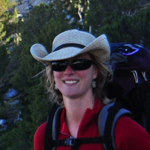
Courtesy Kelly Sivvy
Discover Denali 2012 Research Fellowship:
Kelly Sivy, University of Alaska Fairbanks (Masters student)
Denali National Park and Preserve
Kelly Sivy is interested in using a method that does not require animal capture to determine the presence and relative abundance of furbearers, such as coyotes, red foxes, and lynx in the vicinity of Denali National Park and Preserve. In winter, she plans to survey wildlife tracks and collect scats along snowmachine transects in the Stampede Road corridor. She'll use these surveys and scat to determine if populations of these mesocarnivores change with the availability of prey such as snowshoe hares, the presence of top carnivores (wolves), and a changing climate (i.e., the amount of snow). In addition to gathering baseline data about population sizes of mesocarnivores, she will be able to test a monitoring method that is non-invasive.
Sand-Dune Formation and Human Landuse of Beaverlog Lakes, Denali
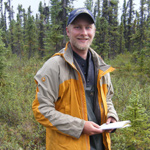
Courtesy Sam Coffman
Sam Coffman, University of Alaska, Museum of the North
Denali National Park and Preserve
In 2011, Sam Coffman was working with Charles E. Holmes on the Ancient Lake Minchumina Project, an archeological study near Lake Minchumina. During that work, the shovel tests they made near Beaverlog Lakes revealed a microblade fragment and a tertiary flake.
In 2012, Sam Coffman will return to the area to gather information to better understand the site and the surrounding landscape. Specifically, he wants to test the Beaverlog Lakes MMK-183 site to: determine whether the site was used extensively or only briefly, whether there is more than one component at the site (one or more occupations), and what activities occurred there; and to recover materials that can be dated, in order to learn the age of the site's use. Sam also wants to learn about the ages of the sand dunes in the area, and how these are related to Lake Minchumina, and how the overlying silt was deposited. Sam will continue his work on the Beaverlog Lakes project in association with the Ancient Lake Minchumina project headed by Charles E. Holmes.
Documenting Natural & Cultural Resource Change Using Repeat Photography
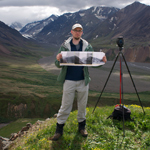
Courtesy Lacy Karpilo
Discover Denali 2012 Research Fellowship:
Ronald Karpilo, Colorado State University
Denali National Park and Preserve
The project involves gathering a library of historic photos (along with the photographer's notes, letters, and journals) and consulting with park staff to determine the highest priority images for repeating. Repeat photography techniques will be used to locate the historic photo sites and create modern images. The resulting photo pairs will document the past century of changes in park features and processes such as vegetation distribution, stream dynamics, glaciers, and post-mining recovery.
Photo pairs will be available for education, scientific and historic research, and resource management.
Ron is a research associate with the Department of Geosciences at Colorado State University.
Holocene Glacial Variability, Arrigetch Peaks, Alaska
Simon Pendleton, SUNY Buffalo (Masters student)
Gates of the Arctic National Park and Preserve
Glaciers in the Brooks Range are in a rapid state of retreat. Knowing more about how long the glaciers have been there, and how they have fluctuated in the past, may help to explain today's Arctic climate systems and their effects on today's glaciers in and near Gates of the Arctic.
Present glaciers in the Brooks Range (specifically the Arrigetch Peaks) may have formed 2,000 to 5,000 years ago. To get more exact dates, Simon Pendleton will use a Cosmogenic Nuclide dating technique that is based on the accumulation of certain isotopes in quartz-rich rocks, such as the granites found in the Arrigetch Peaks.This isotopic analysis of glacially-deposited boulders and eroded bedrock gives accurate absolute ages for the limits of glacial advance (moraines) and the timing of retreat (exposed bedrock).
From a base camp in the Arrigetch Valley, Simon and a field partner will survey three chosen glaciers for rock sampling. He'll later prepare the rock samples back at SUNY Buffalo for isotopic dating.
Understanding Changes in the Land Using Phenological Observations by Local Residents
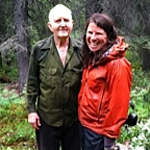
Courtesy Laura Wentworth
Murie Science and Learning Center 2012 Fellowship:
Margot Higgins, University of California Berkeley (Ph.D. student)
Wrangell-St. Elias National Park and Preserve
Margot Higgins plans to gather observations from local residents near Wrangell-St. Elias, about how nature's calendar (phenology) is changing in relation to climate change. Wrangell-St. Elias is home to one of the largest resident zone populations of any national park, where 5,200 people are eligible to practice subsistence activities. Such subsistence lifestyles require knowledge of the seasonal biological events such as migrations, breeding, and the timing of ripening berries. Margot will draw on her interviews with residents, as well as archival research, to help the National Park Service develop a monitoring program for phenology that incorporates the local observations.
Margot has conducted similar work with NPS in California, where she is a PhD candidate in the Society and Environment Division of the Department of Environmental Science, Policy, and Management at UC Berkeley.
Effects of Climate-Induced Changes in Generalist Predators on Artic Food Webs
Amanda Koltz, Duke University (Ph.D. student)
Gates of the Arctic National Park and Preserve
Wolf spiders are the most abundant invertebrate predator in the Alaskan Arctic. Near Gates of the Arctic, these spiders have 36 times more biomass than wolves. That means that what happens to wolf spiders in a warming climate may greatly influence ecosystems, specifically the breakdown of plant material (leaf litter), which, in turn, may affect the amount of greenhouse gases being released.
How do wolf spiders influence these decomposer food webs, and ultimately carbon cycling in park ecosystems? To answer this question, Amanda Koltz will continue working near Toolik Lake, where she has set up an array of 30 experimental circular chambers with a diameter of 1.5 m (5 feet) made out of aluminum flashing. In the chambers, she is manipulating spider density (adding or removing spiders) and temperature (ambient or heated by about 2 degrees Celsius). To determine if spider density and a warmer temperature is affecting soil invertebrates, soil bacteria, and soil fungi, she is sampling these organisms within each chamber, and is also collecting information about how rapidly litter is decomposing.
Amanda Koltz is a grad student in the Nicholas School for the Environment at Duke University.
Dynamics and Red Senescence in Three Northern Plants
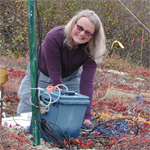
Courtesy Margie MacNeille
Discover Denali 2012 Research Fellowship:
Margie MacNeille, University of Alaska Anchorage (Masters student)
Denali National Park and Preserve
In fall in the nutrient-poor subarctic, in fall, herbaceous plants typically resorb precious nitrogen (N) from senescing leaves to store in stems, roots, or rhizomes. Yellow leaf pigments appear as green chlorophyll (rich in N) is broken down. Red coloration occurs when plants manufacture anthocyanin pigments. Margie MacNeille proposes to show a correlation between the timing of decreasing N and increasing anthocyanins in three red-senescing plants: bearberry, dwarf birch, and bunchberry. She will collect leaves from these three species at intervals across the late growing season into fall, and analyze the leaves for N and anthocyanins. Later she will conduct experimental work in growth chambers to determine if there is a cause and effect between lowering N and increasing anthocyanins.
The Importance of Herbivory in Rapidly Changing Arctic Shrub Communities
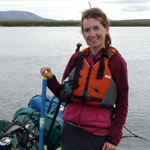
Courtesy Katie Christie
Murie Science and Learning Center 2012 Research Fellowship:
Katie Christie, University of Alaska Fairbanks (Ph.D. student)
Noatak National Preserve and (near) Gates of the Arctic National Park and Preserve
Both Noatak and Gates of the Arctic are among those arctic parks changing in response to a warming climate. One of these changes has been the dramatic expansion of shrubs into tundra areas. Katie Christie is interested in helping these two parks answer the questions: How important are herbivores in structuring arctic shrub ecosystems? How can herbivory be included in models that predict ecosystem change in a warming climate?
From aerial surveys, she will determine whether ptarmigan and moose prefer to browse in certain ecosystem types. On the ground, she'll examine willow branches and stems to record how many buds ptarmigan have eaten, and to estimate the biomass consumed by moose. Furthermore, she'll look for patterns of how the browsing has affected the growth, branching architecture, and reproduction of felt-leaf willows and other shrubs.
Giardia and Cryposporidium in Surface and Treated Water of Denali
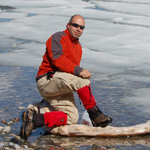
Courtesy Ricardo Santos
Discover Denali 2012 Research Fellowship:
Ricardo Santos, Instituto Superior Tecnico- Laboratorio de Analises, Portugal
Denali National Park and Preserve
This study will test the safety of drinking water in selected areas of Denali. Ricardo Santos will sample treated drinking water (from park headquarters, campgrounds, and visitor centers), and, with the help of backcountry rangers, water from several backcountry streams and tundra ponds. He will test the water for two microorganisms that, when present, can cause diarrhea. The project will also test the performance and efficiency of filters and treatment devices used by campers and hikers to get drinking water. Recommendations based on research findings will be passed along to park managers. Ricardo has studied microorganism biodiversity in locations around the world, including in thermal springs at Yellowstone National Park.
Paleoseismic & Structural Characterization of the Hines Creek / Denali Road Fault
Sara Federschmidt, University of Kentucky (Masters student)
Denali National Park and Preserve
Sara Federschmidt plans to determine the history of earthquakes and slippage along the Hines Creek fault near the park entrance. Some of the features produced by the paleoactivity of this fault are a scarp, and some seismic fissures that cross river deposits laid down in the past by the Nenana River and Riley Creek.
Learning about the past activities of the fault helps determine the present seismic hazards of this active fault, which is near or very near to important infrastructure including the Alaska Railroad bridge over the Nenana River, the Parks Highway, and the electrical intertie. Sara proposes to study the fault using a combination of surface mapping, interpretation of air photos and LiDAR Digital Elevation Models, and excavation of trenches across several fissures.
Sara is a grad student in the Department of Earth and Environmental Sciences at the University of Kentucky.
Last updated: March 25, 2015
